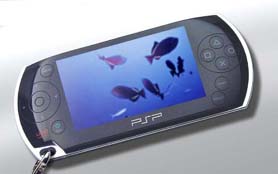
NEW YORK (CNN/Money) � The battle between Sony's PSP and Nintendo's Game Boy Advance, which was shaping up to be one of the biggest clashes of the upcoming holiday season, has been pushed to next year.
Sony has informed publishers, developers and retailers that while it still plans to launch its handheld gaming and entertainment device in Japan this holiday season, the PSP will not hit shelves in North America or Europe until calendar year 2005.
"The reason we pushed it out here is we wanted to be sure there's a reasonable amount of software titles to launch with hardware," said Teresa Weaver, a spokesperson for Sony Computer Entertainment.
The system will ship globally before the end of Sony's fiscal year (which ends in March 2005).
 |
|
| An early mock-up of Sony's PSP. |
While it might also be easy to assume that the delay of the PSP's North American launch signals some sort of problem, that's not likely the case. Sony (and, for that matter, Nintendo) has traditionally launched new products in Japan several months before releasing them in the rest of the world. The original PlayStation hit Japanese stores four months before U.S. consumers were able to buy it. And while the PlayStation 2 went on sale in Japan in March of 2000, it didn't hit the U.S. until October of that year.
"With many of the roots of the gaming industry being in Japan, it's traditional to pay homage and release a hardware product there first and then release in the U.S., even though the U.S. is a bigger market," said P.J. McNealy, an analyst with American Technology Research.
The delay of the PSP, which Sony Computer Entertainment president and CEO Ken Kutaragi called "the Walkman of the 21st century" when it was announced last May, comes as great news for Nintendo, though not necessarily for budget-minded consumers. With no substantial competition, Nintendo will not be forced to lower prices on its Game Boy Advance SP. It still could, of course � and quite possibly will. Even a token drop of $20 (putting the price at $79) could spur late adopters to pick one up.
More importantly, though, not having to contend with the PSP would allow the company to introduce its new handheld system, the Nintendo DS, without being overshadowed by Sony.
The new system, which was announced on Jan 20, remains shrouded in mystery. It will feature two separate 3-inch LCD screens, giving a player dual perspectives (such as an overhead map and a close-up of the action) as he or she plays. Nintendo has said it does not consider the system the successor to either the Game Boy or GameCube, but rather an entirely new product.
More details will be announced at the E3 trade show in May, but the gaming community did not exactly greet initial word of the DS with open arms. Many gamers were skeptical and, in kneejerk fashion, likened the product to the company's failed Virtual Boy console. Released in 1994 (and discontinued a year later due to weak sales), that system evoked user complaints of headaches, poor graphics and a miniscule game selection.

| |
|
Click the orc for previous columns.
|
|
As the gaming world has had time to get used to the idea of the DS, though, opinions seem to have softened. Sega has announced it will create games for the system and other publishers are likely to do so in the coming months.
The PSP, meanwhile, has widespread industry support. Publishing powerhouse Electronic Arts (ERTS: Research, Estimates) plans to have 8-12 titles ready for the system's launch, while THQ (THQI: Research, Estimates) said it will have two or three titles ready.
Sony (SNE: Research, Estimates) has not announced pricing details on the system, but EA CEO Larry Probst last month said the company expects the price to be between $199 and $249.

Morris is Director of Content Development for CNN/Money. Click here to send him an email.
|

